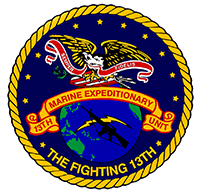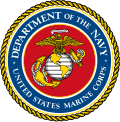1990s
The 13th MEU’s special operations capabilities (SOC) were used extensively on its deployment during Operation Desert Shield and Operation Desert Storm. Beginning a routine deployment 20 June 1990, the MEU was diverted to Southwest Asia in August. The first amphibious force to arrive in the theater of operations, personnel conducted the first Marine offensive actions against Iraq. In October, elements boarded two Iraqi tankers that refused to obey United Nations sanctions. [8]
The MEU’s last combat operation in Desert Storm was an Iraqi prisoner-of-war detainment on Faylaka Island, Kuwait, 3 March 1991, which resulted in 1,413 Iraqi prisoners being apprehended. The MEU returned to the United States 16 April, after being deployed 301 consecutive days. [7]
The 13th MEU (SOC) deployed again in January 1992. During this deployment, the MEU conducted training operations in the Persian Gulf, Africa and Thailand. Additionally, the MEU was the last deploying unit to visit the Philippines prior to the closure of Naval Station Subic Bay prior to returning that summer. [7] The 13th MEU (SOC) arrived off the coast of Somalia in early October 1993 in response to increasing hostilities there. As a key element of the newly formed COMMARFOR Somalia, the 13th MEU (SOC) and 22nd MEU (SOC), remained on station ready to provide support to United States and United Nations forces. [9]
In mid-13 November MEU (SOC) became the principle rapid response force in the region and executed two humanitarian assistance operations. The first, Operation Show Care, took place in the cities of Marka and Qoryooley from 11–14 November. From 1–3 December, Operation More Care was conducted in the Old Port of Mogadishu. Both operations provided needed medical and dental assistance to Somali citizens. [7]
The 13th MEU (SOC) continued its presence mission through January 1994, providing aircraft for the "Eyes Over Mogadishu" missions as well as sniper support at the United States Embassy compound. The 13th MEU returned to the United States 17 March. [7]
The MEU deployed again 25 October, only seven months after returning to Camp Pendleton. Following a scheduled exercise on Okinawa, 11–13 November, the MEU sailed to the Persian Gulf. During this period the MEU conducted a Maritime Interdiction Operation/Visit Board Search and Seizure (MIO/VBSS) mission aboard the Honduran-flagged merchant vessel Ajmer, which was in violation of United Nations sanctions on Iraq. [10]
In January 1995, the 13th MEU (SOC) was ordered to conduct Operation United Shield - the withdrawal of UNOSOM forces from Somalia. The MEU sailed to Africa and conducted operation rehearsals in Kenya. On 28 February, the 13th MEU (SOC) conducted an amphibious assault onto Somali soil and executed a relief-in-place with UNOSOM forces. By 2 March, the withdrawal of all UNOSOM forces was complete, and during the first hours of 3 March, the final Marine forces departed Somali soil. The 13th MEU (SOC) returned to Camp Pendleton 24 April. [7]
The MEU departed on its ninth deployment 19 April 1996. During an MEU exercise in Kuwait, the MEU became the first MEU(SOC) to put the entire landing force ashore in Kuwait without the use of a port or airfield. [11] This was a vital step in the validation of the plan for the defense of Kuwait, which had previously not been tested. [12]
The "Fighting 13th" returned to Camp Pendleton to end its deployment 18 October. The 13th MEU(SOC) began its tenth deployment 29 August 1997. During WESTPAC 98-1, the MEU participated in Operation Southern Watch during November and December, helping enforce the no-fly zone over southern Iraq. The MEU returned home 28 February, 1998.
5 December 1998, began WESTPAC 99-1. During deployment, the MEU conducted training in Hawaii, Singapore and Kuwait. MEU Marines provided reinforcements to the U.S. Embassy in Kenya and responded to the Eritrea-Ethiopia war.
While deployed in the WESTPAC from 14–16 September 2000, the MEU conducted a humanitarian assistance operation in East Timor, offloading more than 570 tons of material by aircraft and more than 430 tons via sea lift.
In October 2000, the 13th MEU was dispatched to provide security and assist in Operation Determined Response, the recovery of the crippled destroyer USS Cole in the port of Aden, Yemen. The MEU marked its transit home with a stop on Iwo Jima, and Tarawa, returning to Camp Pendleton 13 February 2001.



